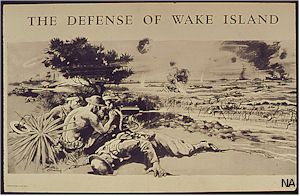
Posters such as this one, by artist Arbin Henning, graphically illustrated the desperate struggles taking place on America's Pacific outposts.
History:
Prewar -
1941 -
1942 -
1943 -
1944 -
1945 -
Postwar
The Ship -
All Hands -
Decorations -
Remembrance
Along with Guam, Wake Island was one of the key American outposts in the central Pacific, a vital part of the supply line between Hawaii and the Philippines. A small atoll 2300 miles west by southwest of Hawaii, Wake was one of the first objectives of Japan's military planners. Located just outside the Japanese Mandate Islands - including Truk, the Marianas and Marshall islands, and Palau - Wake was within striking range of Japanese bombers based on Kwajalein to the south. Flat, and with few natural defenses, the island presented an easy target for invasion.
While Enterprise was only tangentially involved in the battles for Wake Island, the story has an important place in her history. Days before Pearl Harbor, Enterprise had delivered the Marine pilots and planes of squadron VMF-211, who played a vital role in the island's defense. The incredible courage of the island's defenders deserves to be remembered.
Just hours after the last Zero had left the skies over Pearl Harbor, 34 Japanese bombers swept out of the rain and fog over Wake Island, blasting and strafing the airfield, fuel storage tanks and other facilities on the atoll. Composed of three small islands - Peale, Wilkes, and the main island Wake - the atoll was home to 450 Marines and sailors, as well as nearly 1500 civilians, including employees of Pan Am, which operated a hotel and seaplane station as part of its Philippine Clipper service.
 Posters such as this one, by artist Arbin Henning, graphically illustrated the desperate struggles taking place on America's Pacific outposts. |
Aided by the weather, the attackers enjoyed nearly complete surprise, killing 52, including 18 Marines, and destroying 7 of the precious Grumman F4F Wildcat fighters which Enterprise had delivered to the island just a week before. After the strike, the wounded and a few lucky others were loaded on the Martin 130 flying boat docked at the island, and evacuated to Hawaii. The Marines and others remaining on the island braced for the next attack, and for the arrival of an enemy cruiser and destroyer force the Clipper pilot had sighted over the horizon.
The bombing raids - launched from Roi, in the Kwajalein atoll some 700 miles south - continued for the next three days, taking their toll on the island's defenders, and grinding the Marine's fighter squadron down to four flyable planes. With these planes, six 5-inch and twelve 3-inch anti-aircraft guns, the Marines greeted the Japanese landing force that appeared early December 11. (Dates for events on Wake are localized to Wake, which is west of the International Date Line.)
The invasion force consisted of three light cruisers, six destroyers and two transports carrying an Imperial Marine detachment, under the command of Rear Admiral Kaijou Sadamichi. Approaching from the south, the cruisers and destroyers began shelling the atoll at 0522 that morning. A little more than forty minutes later the force had approached to within 2,500 yards of Wake, and the transports were moving in, closely escorted by the destroyers. Having held their fire during the Japanese bombardment, at 0610 the Marine gunners came to life.
On Peacock Point - the southern tip of Wake - Lieutenant Clarence Barninger's battery engaged Kajioka's flagship, the cruiser Yubari, and quickly scored four direct hits. Sergeant Henry Bedell's gunners on Peale island wasted just two rounds finding their range, and then tore into the destroyer Hayate, which exploded, broke in two and sank. Jubilant over their unexpected success, Bedell's crew stopped firing and broke into celebration, until Bedell's outraged roar restored discipline.
Resuming fire, Bedell's battery, and other gunners on Peale, scored hits on the other three destroyers, and set one of the transports on fire. With the invasion force in disarray, the four Grumman fighters joined the fray: one of the fighters, strafing the destroyer Kisaragi, detonated the depth charges on the destroyer's aft deck, mortally wounding the ship.
Kajioka, his own flagship already retiring, called off the assault. The 450 Marines on Wake thus earned the noble distinction of being the only force in the entire war to defeat an amphibious assault.
Image Library -
Action Reports and Logs -
News Stories
Message Boards -
Bookstore -
Enterprise CV-6 Association
Copyright © 1998-2003 Joel Shepherd ([email protected])
Sources and Credits